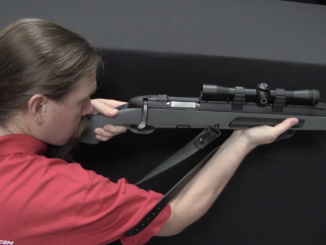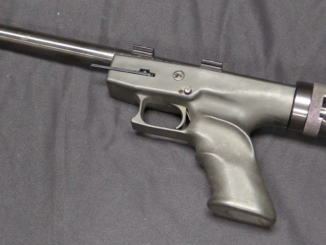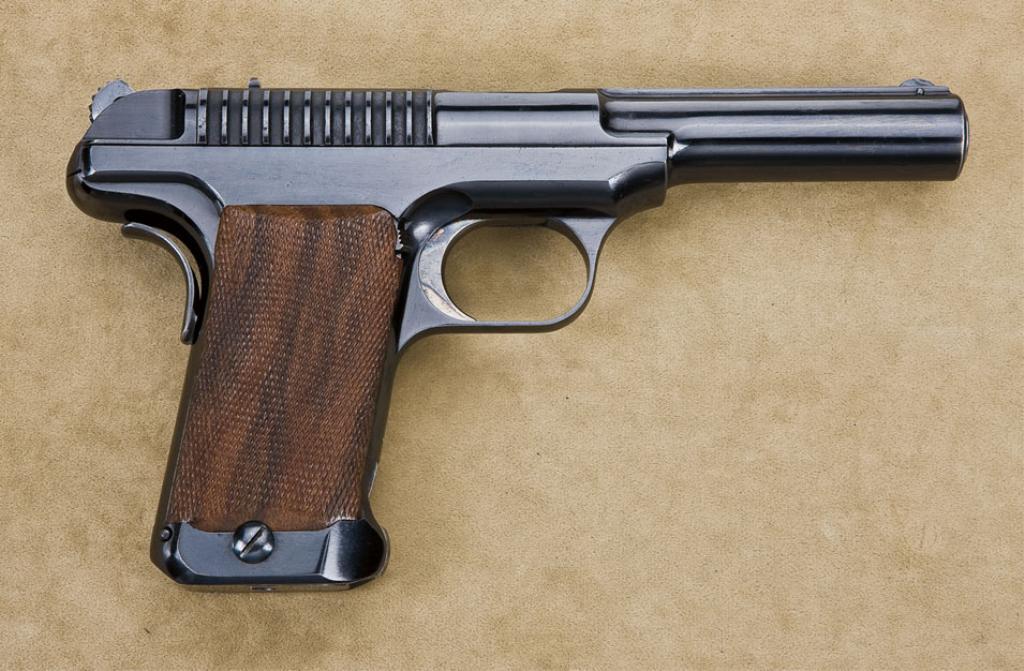Lot 11 in the September 2020 RIA Premier auction.
Ammunition for the Volcanic Repeaters is extremely rare today, and this opportunity to take a look at a complete original box of it was something I did not want to miss. There were two calibers made; the .31 (Cartridge No.1) and the .41 (Cartridge No.2). Both were sold in tin boxes of 200 rounds, originally costing $10/thousand for the .31 and $12/thousand for the .41. The ammunition was made by Crittenden & Tibbals of South Coventry – a company which would eventually become Union Metallic Cartridge (UMC) and is still in business today. The ballistics of the No.2 we are looking at today were a 6.5 grain charge of black powder propelling a 100 grain projectile at about 260 feet/second. In other works, exceedingly underpowered even for its day. However, it was a waterproof, self-contained cartridge before the metallic cartridge case was refined enough to work reliably, and that was worth a lot.




Looking at that design. So close. If you could go back and say to any gun designer, “Why don’t you just. . .” who would it be and what gun?
I love this type of question! There are SO many possibilities, so I’ll confine my responses to mid-century SMGs:
1. Reduce the Skorpion’s rate of fire better than its complicated rate reducer does by simply adding a little bolt mass and using the room at the rear of the receiver for free recoil.
2. For Gen2 (stamped / tube) SMGs, use a trigger right behind the mag (like the Thompson, one of the first Gen1s) and elevated sights so the shooter could rest his face on the rounded, ergonomic receiver (covered in leather, etc.) instead of a sharp, complex, rattly POS folding stock.
3. Given that blowback semiautomatic pistols with these features originated at the turn of the century, it shouldn’t have taken:
A. Until the 50s to put the magazine in the grip (Gen3) of pistol-caliber SMGs and use a “telescoping bolt”, even though it’s simpler to sear the bolt right above the trigger than to wrap a FCG around the magazine.
B. Until the PM-63 in the 60s to substitute a 1900-vintage slide for the [more complicated] “telescoping bolt”.
C. I’d go a step further and – since the slide is only bearing a load equal to the strength of the recoil spring – make it from tubing, with a separate bolt at the rear and bushing at the front.
“(…)For Gen2 (stamped / tube) SMGs, use a trigger right behind the mag (like the Thompson, one of the first Gen1s)(…)”
Wait, this sound like PPSh-2, see 1st photo from top:
https://modernfirearms.net/en/submachine-guns/russia-submachine-guns/ppsh-2-eng/
I was thinking more specifically of the types with the extra-long receivers (PPS-43, MP-40) that could easily have provided a reasonable LOP themselves if the designers hadn’t stuck the pistol grip at the rear for no good reason.
Even with the mid-length receivers (STEN), my preference would be to extend the tube (thereby reducing recoil and ROF) and stick a buttplate or recoil pad on the endcap rather than tack-on a LESS ergonomic stock.
On that note, I’m surprised there was never (at least as far as I can recall) a transitional model between Gen2 and Gen3 – i.e. an Uzi-type mag-in-grip on a tubegun.
“(…)Uzi-type mag-in-grip on a tubegun(…)”
This sound like description of MGP-84
https://modernfirearms.net/en/submachine-guns/peru-submachine-guns/mgp-84-eng/
“An Uzi-type mag-in-grip on a tubegun” is an accurate description of the Czech Samopal 48 aka Vz. 23 through 26 SMG family;
https://en.wikipedia.org/wiki/Sa_vz._23
And it was in service several years before the Uzi (1949-50 vs. 1954-56).
Maxwell Atchisson also came up with a similar prototype, the Model 57;
https://vignette.wikia.nocookie.net/guns/images/0/0c/Atchisson.png/revision/latest?cb=20180606075102
Note the magazine interface/”grip”; it’s an MP40 mag housing turned backward.
And of course there is the Mendoza HM3 that has been in Mexican army and police service since 1959;
https://modernfirearms.net/userfiles/images/smg/smg116/mendoza_hm3_1.jpg
While it’s been made in 9 x 19mm all these years, recently a 9 x 17 (.380 ACP) version has been introduced specifically for the police. Exactly why, would be interesting to find out, as it would seem that the last thing the Mexican police need in what amounts to a full-on civil war would be a less powerful PDW.
cheers
eon
Daweo and Eon,
I should have been more clear. I’m familiar with most of those, especially the Czech SMGs and the fact that they predated the Uzi. They are all clear-cut Gen3s with complex telescoping bolts. Even the ubiquitous Uzi and MACs are tubeguns, albeit with rectangular tubes.
What I meant by “a transitional model between” is that I’m surprised I’ve never seen a Gen2 (like the STEN) with a conventional bolt, except modified with the mag well as the grip; a bar from a forward-mounted trigger actuating the sear (several have bars counterproductively extending the trigger the other way), and the buttplate on the endcap.
One could even have reconfigured a Gen1 like the MP18 along those lines. There’s a cool “What if?”: imagine if, instead of the P-38, the Luger’s replacement had been a select-fire, tube-receiver ~18″ long 9mm PDW, issued to officers and NCOs plus tankers, pilots, Fallschirmjager (mixed formations with FG-42s), collaborationist militias etc. 15rd “carry” mag and 30-32rd spares
“(…)Until the 50s to put the magazine in the grip (Gen3) of pistol-caliber SMGs and use a “telescoping bolt”(…)”
Does sub-machine gun by Рукавишников from 1942 year count as “telescoping bolt”, see 1st photo from bottom: https://www.kalashnikov.ru/kto-pervyj-opytnyj-pistolet-pulemyot-rukavishnikova/
?
I don’t read Cyrillic, but I think that’s along the lines I was picturing – thanks! I wonder why it wasn’t more common.
Metal storm. Semi auto version, probably “Actually there’s more, with hindsight he he.” Make a pistol with a free floating barrel*; but mounted from the front, then have the (mag) use circular propellant charges, er rings of “powder” that fit around the barrel. Barrel full of projectiles. Say 4 ports in the barrel two up, two down. Over… Well imagine these Volcanic cartridges stacked in a barrel thus, said ports want to be over the cone bit of the bullet; so as to allow a gap for gas- Behind the next bullet, type thing. The mag has a rack and pinnion type action, that when you pull the trigger the tube (holding the propellant rings) moves back everytime you pull the trigger. The mag tube is “cut” perforated like, so that when it moves back a riser (A thinghi) pops up when you release the trigger and seperates the tube section which moved back; over your hand, in order you don’t get a full tube moving back… Think of the mag tube as a case, so it seperates… Like machine gun link. Say. Anyway. With *= four barrels, he he; 8 bullets in each 5″barrel approx 32 rounds’ish.
Burp. Probably has some problems, he he. But meh. Point being 32 rounds, semi, in a wee gun “powder rings want to be, more powerfull than the Volcanic” commerce wise, makes the metal storm more… Viable for shooting. Albeit it is a different concept, and has been done before kind of with moving percusion locks and so forth… Still probably an improvement on them. Probably he he.
Might not be an improvement; probably should have thought about the question more, he he.
Yes it was one barrel, when I started typing that 5 mins ago; I can see 4 barrels complicate the issue, but are kinda needed for the mag capacity… So point. Probably could make it work, with a pen and some paper. Perhaps, he he. 32 rounds…
Easy reloads you have four tubes, as a sort of revolver speed loader; break action maybe. Anyway thats enough of that, he he.
Heavy trigger pull. The “case” seperator could be like a sort of revolving striker… In four barreled derringers. Pop, pop, pop, pop, type thing… Anyway, he he.
Mounted in the middle of the four two up, two down barrel cluster; the workings… Mounted from the front; the workings. Might work.
Oh you’d need a seperate barrel “bullet” speedloader eh, with the “cases” being seperate from the bullet. Polymer, barrel inserts attached… to the charge tubes No rifling, short range; more capacity.
32 rounds quite a lot, in a wee gun. Not much more use… Mind you if it was longer 10″ barrel you get 32 rounds and 5″ of rifling. Been reading Walden 1854 also funnily enough two 83 year olds to get back then 166 years hence why I know that.
Very thin say alu “case” tube… That inserts into steel… Er well barrel tubes eh; to contain pressure. Mag probably about the size of 4 glock “normal” ones so kinda bulky, but the gun is small for 32 rnds.
Funny isn’t it: To get any “advance” maybe you need to lose the previous advance of bullets and propellant being in the same thing I.e. A cartridge. Caseless/telescopic rounds per se, still “stack” in a g11 or such mag, not much space saving.
I.e. The mags, the size of 4 Glock ones stuck together. Interesting gun anyway the Volcanic, if for no more reason than it sparked off the lever action “which had rounds of a useable power” which is important clearly.
It is based on the V3 cannon, sort of… Lots of wee ports and charges, but used differntly.
So Lee wasn’t the first one to market the tumble lube bullet?
Viability (and by implication, detonation safety) of these today?
And on safety, lots of lead oxide in evidence, not to mention the likely mercury fulminate primer.
Don’t eat these, kids. Heck, I would wear gloves handling them.
I’m surprised the brass base & primer didn’t get left in the chamber. Very neat stuff you bring us, Ian. Thank you.
That has always puzzled me about the Volcanic round, as well. The original “rocket ball” for the .54 caliber Hunt and Jennings rifles had a disc of cork sealing the base of the bullet, with a tiny hole so the flare from the separate-primed firing mechanism could reach the powder charge. The cork was consumed by the powder combustion, theoretically.
But both versions of the Volcanic ammunition had a brass “cup” or disc sealing the base of the projectile, as Ian and the diagram showed. Either way, this would seem to be destined to leave a piece of brass in the chamber with each shot.
So how was it disposed of?
I think the only way to find out for sure would be to find a Volcanic rifle or pistol (or build one), manufacture new ammunition to the original specification, take it out to a range, and actually test-fire it.
BTW, a 100 grain bullet leaving the muzzle at 260 F/S has a ME of 15 FPE. Even then, there were “muff” pistols with more hitting power.
On that note, in The Civil War Collector’s Encyclopedia by Francis A. Lord (1963), we find this entry on the subject;
Of course, he forgot to mention (or maybe just didn’t know) that the Volcanic continued in production until 1859 under the Smith & Wesson trademark. At which point Horace Smith and Daniel Baird Wesson sold out the Volcanic patents to a shirtmaker named Oliver Winchester.
He hired Benjamin Tyler Henry to make something more reasonable- and useful- out of the Volcanic, and as they say, the rest is history.
cheers
eon
“leave a piece of brass in the chamber with each shot”(C)
Usually, such residues are carried away by gases.
And the unburnt remnants of the cork, at such pressures, do not pose a threat.
As with obturation, when the burning powder charge’s expanding gases pushes the bullet forward, they should flatten the brass disc against the breechface, in this case the front end of the bolt. So that disc really shouldn’t go anywhere.
If there were a slot in the back end of the lifter carrier, I suppose it could fall straight down and out when you racked the lever to reload, provided that the weapon was not canted to one side or the other. More likely, you’d need to invert the arm and shake it out, or reach in to the (hot) breech with a finger and thumb and pluck it out (still hot).
Even if the disc were brass foil, like some early metallic cartridges (.577/450 Martini-Henry standard issue), I don’t see it just being consumed by firing. It has to go somewhere.
cheers
eon
“As with obturation, when the burning powder charge’s expanding gases pushes the bullet forward, they should flatten the brass disc against the breechface, in this case the front end of the bolt. So that disc really shouldn’t go anywhere.”(C)
Your enthusiasm is undoubtedly commendable.
But, perhaps, sometimes, it is useful to consult school textbooks?
Following Your logic, a person is not thrown into space because he is pressed to the ground by atmospheric pressure. 😉
There is NO complete obturation, therefore, the pressure on ALL sides of the gasket is approximately the same.
After the bullet leaves the muzzle, a pressure difference arises, with a decrease towards the muzzle.
This difference is quite enough to carry out most of the items that are inside the cartridge.
In some cases, something may stay inside the barrel, but usually, everything that does not cling to the channel walls, flies out after the bullet.
Umm, possible, in the same way that when an explosion occurs, there is an outwash of debris, followed by an inrush of air into the low pressure area created by the wavefront, which results in lighter pieces being sucked back in toward the center.
But this is more of a case of equal pressure in two directions in a confined cylindrical volume. So the pressure diagram would be more like this;
Breechface I disc bullet >>>
Again, that disc should be hard up against the breechface. The pressure drop afterward might carry it out the muzzle, but I wouldn’t bet on it.
cheers
eon
“(…)“Rocket Ball”(…)”
Interestingly, idea re-appeared at least few times in history, including recent development named 308 SCA Semi-Caseless Ammunition by Wild Arms Research see photos: https://www.thefirearmblog.com/blog/2020/08/06/308-sca-semi-caseless-ammo/
At a certain point, I’m going to start thinking that Ian has discovered a vein of Unobtainium beneath is basement lair in AZ and is just cranking this stuff out at will; laughing with his pinkie at the corner of his mouth &c.
Good thing Congress didn’t hear that, because Unobtainium is worth several tens of thousands of bucks per pound! Just kidding.
We should all run out and buy gyrojet cartriges for our great grandchildren
They are already expensive but still less then volcanic rocket balls
The muzzle energy matches that of a vigorously thrown billiard ball, which may lack stopping power but has plenty of slowing down and making one think about things power.
Especially in the days when Lister was just a beginning doctor, Pasteur was a chemistry teacher, and Semmelweiss was headed for the crazy house.
Wilcox-Crittenden Mfg. is a maker of nautical hardware. The company was founded in Connecticut in the mid 19th century. Maybe a related Crittenden?
Didn’t Smith and Wesson or Winchester/Henry make an attempt at a later version with a small brass of copper base?
There existed Remington Rider magazine pistol by Joseph Rider see 1st photo from top: http://www.littlegun.info/arme%20americaine/remington/a%20remington%20rider%20gb.htm
which was mechanically similar to Volcanic, but used rim-fire cartridge, though I do not know if these were “(…)of copper base(…)”
THANKS!
Cool, thanks for posting that. About that Remington Rider…so, you use your thumb on the big lever, which lets a new round into the chamber area and cocks the hammer, then you push it back forward (the big lever), or a spring pulls it forward again, that chambers the round in battery and then you fire. If you don’t want to fire, you can hold the hammer and pull the trigger and let it go down presumably into a half cock position. Then manually cock it later. Guessing here…
Actually, the Remington-Rider pistol breech and hammer were a single piece. You cocked it, and when you squeezed the trigger, the hammer seared off, carrying the round up into the chamber and firing it when the hammer/breech hit the rim and crushed it against the chamber mouth.
You pulled the hammer back, ejecting the expended cartridge, and when it reached full cock it was ready to fire again.
Yes, it worked very much like an advanced primer ignition submachine gun, in that it always began its firing cycle with the “bolt” open and the chamber empty.
cheers
eon
100 grains at 280fps…wow. That’s Daisy Red Rider BB gun velocity (though with a bigger projectile, obviously).
So how small was the powder charge on the .31″? 3 grains or so?